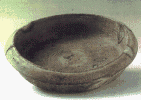
Combs 
52.3, 52.3a
Comb A: length 6 cm (2 3/8 in.)
width 9.5 cm (3 3/4 in.)
Comb B: length 6.3 cm (2 1/2 in.)
width 8 cm (3 1/8 in.)
Courtesy of the Israel Antiquities Authority (85, 86)
Similar to most ancient combs, these combs are two-sided.
One side has closely-spaced teeth for straightening the hair, and
the other side provides even more teeth for delousing the scalp.
Both combs are fashioned from boxwood.
Bowl 
52.40 Height 4.9 cm (1 15/16 in.) Diameter 26 cm (10 1/4 in.) Courtesy of the Israel Antiquities Authority (87)This deep bowl has a flat base, expertly turned on a lathe. Several concentric circles are incised in its base, and the rim of the bowl is rounded. Most wooden objects found in the Qumran area are of "acacia tortilis," a tree prevalent in the southern wadis "valleys" of Israel.
